Ivan Čuk
Editorial
Maja Bučar Pajek, Petr Hedbávný, Miriam Kalichová, Ivan Čuk
THE ASYMMETRY OF LOWER LIMB LOAD IN BALANCE BEAM ROUTINES
Timothy J. Suchomel, William A. Sands, Jeni R. McNeal
COMPARISON OF STATIC, COUNTERMOVEMENT, AND DROP JUMPS OF THE UPPER AND LOWER EXTREMITIES IN U.S. JUNIOR NATIONAL TEAM MALE GYMNASTS
Aurore Huchez, Diane Haering, Patrice Holvoet, Franck Barbier, Mickael Begon
DIFFERENCES BETWEEN EXPERT AND NOVICE GYMNASTS PERFORMANCE OF A COUNTER MOVEMENT FORWARD IN FLIGHT ON UNEVEN BARS
Saša Veličković, Miloš Paunović, Dejan Madić, Vladan Vukašinović, Edvard Kolar
PROPOSED METHOD OF IDENTIFICATION OF TECHNICAL ERRORS IN ARTISTIC GYMNASTIC:
María Alejandra Ávalos Ramos, María Ángeles Martínez Ruiz, Gladys Merma Molina
GYMNASTICS DISPOSITIONS AND SKILLS: A CASE STUDY LISTENING TO THE VOICES OF TEACHERS
Elizabeth Paoliello et al.
PARTICIPATION OF THE PAN-AMERICAN GYMNASTICS UNION IN THE 2011 WORLD GYMNAESTRADA
Catarina Leandro, Lurdes Ávila-Carvalho, Elena Sierra-Palmeiro, Marta Bobo-Arce
TECHNICAL CONTENT OF ELITE RHYTHMIC GYMNASTICS
Anton Gajdoš
Historical Notes V
Expert and scientific meetings
Ivan Čuk
Editorial
Dear friends,
We are entering into the eight year of our joint travel through science of gymnastics. We are starting new year with excellent news. Our journal will be now visible also in Web of Science in Core Collection. Web of Science have now new part, which is called ESCI- Emerging Sources Citation Index and it was established last year. We received information of inclusion after we published October issue last year. So our articles are now included into two very important data bases – Scopus and Web of Science.
The first four article are from biomechanics and the first article comes from Slovene and Czech authors Maja Bučar Pajek, Petr Hedbávný, Miriam Kalichová and Ivan Čuk. They did simple research by methods, but important by results. Women gymnastics on balance beam significantly influences one sided load, therefore rises bilateral asymetries, which are one of important reasons for ijnuries.
The second article is from United States of America, authors Timothy J. Suchomel, William A. Sands and Jeni R. Mcneal are sharing their experience with US male junior national team on their abilities measured on tensiometric plate. As their subjects are one of the best in the world it is worth to take their results to compare with your juniors.
The third article is from combined France and Canadian team of researchers Aurore Huchez, Diane Haering, Patrice Holvoet, Franck Barbier, Mickael Begon, thir article is about women artistic gymnastics, uneven bars, transition from low to high bar. Comparision between low and high level of gymnasts give coaches clear guideline where to direct their attention.
The fourth article is from Serbian and Slovene contributors Saša Veličković, Miloš Paunović, Dejan Madić, Vladan Vukašinović, Edvard Kolar, with similar idea as previous article, to focus coaches on their gymnasts when perform basket to handstand on parallel bars.
The fith article is from Spain researchers María Alejandra Ávalos Ramos, María Ángeles Martínez Ruiz, Gladys Merma Molina and thir resarch is valuable for all us teachers who do teach students about gymnastics, the most important guide to us is we should focus to real conditions which are in classes in primary and secondary schools.
The sixth article is from a huge Brazilian and Portugal team (consisted of 10 members) and they give us information about general gymnastics, more specific we get insight on how Pan American Gymnastics Union members contribute to the World Gymnaestrada.
The last article is also combined with researchers from two countries, Spain and Portugal. Catarina Leandro, Lurdes Ávila-Carvalho, Elena Sierra-Palmeiro, Marta Bobo-Arce prepared analyse of technical content of elite rhytmic gymnastics. It is worth to notice, their analysis would be benefitial to FIG RGTC to improve their rules.
Anton Gajdoš in Short Historical Notes V prepared a memo about the Alois Hudec, Eugen Mack and Czechoslovakia team of 1938. New content in journal is list of reviewers, who helped us last year with their knowledge. Just to remind you, if you quote the Journal: its abbreviation on the Web of Knowledge is SCI GYMNASTICS J.
I wish you pleasant reading and a lot of inspiration for new research projects and articles.
Maja Bučar Pajek, Petr Hedbávný, Miriam Kalichová, Ivan Čuk
THE ASYMMETRY OF LOWER LIMB LOAD IN BALANCE BEAM ROUTINES
The asymmetry of use of lower limbs may influence balance beam results and injury risk. This research was performed to study how many elements which asymmetrically load lower extremities are included in balance beam routines of professional female gymnasts. We video-recorded all exercises of qualification round on balance beam at an international competition B World Cup in Ljubljana 2014. We analysed take-offs and landings to define the actions done by left leg, both legs simultaneously, or right leg. A delay of at least 0.01 second in recruitment of one of the lower limbs defined the action as being from a single leg. In the routines of 19 included gymnasts we found significant asymmetry of load: right leg initiated 42.87% of actions (on average 12.47±3.32 per routine), while left leg and both legs initiated 29.08 and 28.05 % of actions (on average 8.58±2.97 and 8.21±3.07 per routine, respectively). The load on right leg was significantly larger compared to left leg and both legs (p=0.002 and 0.003). Only 4 gymnasts (20.8%) loaded left leg more than right leg. Additional review of code of points revealed that it mostly contains elements (in 60% of cases) where a single leg at take-off or at landing is loaded. We conclude that asymmetric lower limb loading is present at balance beam routines in elite gymnasts. We hypothesize that the unilateral distribution of load may be associated with the unilateral predominance of injuries and this should be analysed in further research.
Key words: female, artistic gymnastics, injuries, lateralization
Timothy J. Suchomel, William A. Sands, Jeni R. McNeal
COMPARISON OF STATIC, COUNTERMOVEMENT, AND DROP JUMPS OF THE UPPER AND LOWER EXTREMITIES IN U.S. JUNIOR NATIONAL TEAM MALE GYMNASTS
Twenty-one gymnasts performed two repetitions each of upper (UE) and lower extremity (LE) static (SJ), countermovement (CMJ), and drop (DJ) jumps on a force platform. Average measures of maximum jump height (MXHT), peak force (PF), rate of force development (RFD), and peak power (PP) were calculated for analysis. In addition, sample-specific allometric scaling was used to scale PF and PP. Four 2x3 repeated measures ANOVAs were calculated for analyses. Statistically significant main effects were observed for UE vs LE for MXHT, PF, RFD, and PP (all p < 0.001). Statistically significant main effects for jump-type were also observed: MXHT, PF, RFD, and PP (all p < 0.001). Finally, statistically significant extremities x jump-type interaction effects were obtained for MXHT, PF, RFD, and PP (all p < 0.001). These gymnasts showed better performances in CJs relative to SJs, but performances were unexpectedly poorer in the DJs. Despite using rebound-type jumps in tumbling and vaulting with UE and LE, the DJs did not appear to capture the athletes’ stretch-shortening cycle skill or may reflect poor stretch-shortening cycle skill.
Keywords: stretch-shortening cycle, vertical jump, force analysis, gymnastics.
Aurore Huchez, Diane Haering, Patrice Holvoet, Franck Barbier, Mickael Begon
DIFFERENCES BETWEEN EXPERT AND NOVICE GYMNASTS PERFORMANCE OF A COUNTER MOVEMENT FORWARD IN FLIGHT ON UNEVEN BARS
This study investigated the different strategies exhibited by expert and novice gymnasts in counter movement forward in flight on uneven bars. Eleven gymnasts performed three trials connected with a kip to support. The gymnasts were divided into two groups according to their ability to connect: six able (termed as experts) versus five non-able (novices). The 3D motion data were collected at 250 Hz. Biomechanical parameters were computed at release (release state and angular momentum), during aerial phase (duration, minimum value of the moment of inertia) and at regrasp (total duration and rotation angle). Robustness of the release state was also compared. Significant differences were found between groups in the three phases. The novice gymnasts performed as robustly as expert gymnasts but less efficiently because they released the low bar before their centre of mass passed the horizontal, with a lower vertical velocity, resulting in a lower and shorter aerial phase. They also had a larger minimum moment of inertia in flight. Coaches could help novice gymnasts to decrease their dependency on their robust technique by improving the release angle. Exercises, which may allow novice gymnasts to exceed the threshold of a 90° rotation angle at release are suggested.
Keywords: technique, expertise, counter movement forward in flight, kinematics.
Saša Veličković, Miloš Paunović, Dejan Madić, Vladan Vukašinović, Edvard Kolar
PROPOSED METHOD OF IDENTIFICATION OF TECHNICAL ERRORS IN ARTISTIC GYMNASTIC:
The aim of this study was to identify technical errors in artistic gymnastics, with comparative kinematic analysis of two gymnasts of different levels of success. The sample for comparative kinematic analysis consisted of ten attempts basket to handstand performed without technical errors by top gymnast and ten attempts performed with technical error by the middle-class gymnast. Kinematic analysis was performed with the help of 3-D video system for the APAS kinematic analysis, using a model with 17 points and 15 segments. Statistical significance of obtained mean differences between the two groups of attempts was determined using t-test for independent samples. Obtained results indicated that attempts performed flawlessly have significant greater speed of center of body gravity, point of hips and peak of feet; center of gravity of body is further away from the axis of rotation, and position of hang under is achieved with a greater angle in shoulder joint, and smaller in the hip joint; phase of front swing in hang under is realized with higher extension speed in hip joint and with expressed anti – flexion in the shoulder joint. All the above stated contributes to leave bars much later and again reach for with stretched arms, and thus there were no errors in the execution. Obtained information about the differences in performing between top gymnast and middle class gymnast have contributed to the identification of technical errors during execution and represents very important step in detection and elimination of them, generally in artistic gymnastic, not only for the specified element.
Keywords: artistic gymnastics, kinematic analysis, identification, technical errors.
María Alejandra Ávalos Ramos, María Ángeles Martínez Ruiz, Gladys Merma Molina
GYMNASTICS DISPOSITIONS AND SKILLS: A CASE STUDY LISTENING TO THE VOICES OF TEACHERS
Faced with the problem of the gradual disappearance of gymnastics in the Spanish curriculum, the aim of this research is to analyse the thinking and experiences of a group of physical education teachers as regards the teaching of gymnastics skills. More specifically, this research investigates teachers’ views on their initial physical education at the university, and their perceptions of difficulties they experienced at the beginning of their professional lives. The methodology employed is qualitative using Aquad 7 program to support the interpretative process. The findings show that the participants considered that their initial physical teacher education curriculum did not give them the procedural knowledge necessary to carry out their gymnastic teaching effectively. As regards the beginning of their careers as teachers, although a group of participants stated that they had implemented educational gymnastics satisfactorily, two groups put forward a negative vision. Of these, one group taught gymnastics but did not feel fully prepared to do so, which made them anxious and insecure, and the other group did not teach gymnastics at all because they lacked the necessary conditions and resources. The results suggest that initial teacher education should be receptive to the initial teacher’s needs and constraints in the gymnastic field.
Keywords: initial physical teacher education, gymnastic, novice teachers, reflective professional practice.
Elizabeth Paoliello et al.
PARTICIPATION OF THE PAN-AMERICAN GYMNASTICS UNION IN THE 2011 WORLD GYMNAESTRADA
This paper focuses on the World Gymnaestrada (WG), the largest international Gymnastics for All festival, organized by the International Gymnastics Federation (FIG). The aim was to analyze the participation of the National Federation members of the Pan-American Gymnastics Union (PAGU) in the 14th edition of the WG, held in Lausanne, Switzerland, in 2011. The data collection was made by a semi-structured questionnaire with eight of heads of delegation of the eleven participating American national federation. The results highlight the largest delegations were Brazil, Canada and the USA, respectively, countries which also traditionally participate in this festival. The participants were majority female (74,5%) and the performance were strongly influenced by Artistic and Rhythmic gymnastics disciplines, as well as Dance. PAGU participation has increased in compare with past editions of the WG, ranking it as second in terms of continent with the largest number of participants (6,64%). Although the participation is strongly related to the economic factors, considering all the WG editions held in Europe. We conclude that non-competitive gymnastics still treat secondarily for most PAGU Member Federations, since they are focus on competitive gymnastics disciplines and especially on their national teams.
Keywords: general gymnastics; gymnastics for all; North America; Central America; South America; gymnastics festival.
Catarina Leandro, Lurdes Ávila-Carvalho, Elena Sierra-Palmeiro, Marta Bobo-Arce
TECHNICAL CONTENT OF ELITE RHYTHMIC GYMNASTICS
The primary aim of this study was to analyse all technical elements used in the Rhythmic Gymnastics Kiev World Championship 2013, and identify the Structural characteristics of the technical content of elite Rhythmic Gymnastics individual routines. The data has been collected from the difficulty forms concerning 288 individual routines. To allow the comparison between gymnasts with different levels the individual routines were clustered into 3 subgroups according to their final ranking competition. Body difficulty elements were organized, according to the composition requirements stated in the RG Code of Points (FIG, 2012). Non-parametric tests - Kruskal-Wallis, Mann-Whitney and Friedman test were applied to determine whether there were significant differences between groups. As main results we can point out that in general the rhythmic gymnasts used similar body difficulties with limited variety. The highest valued elements are Dynamic Elements with Rotation and throw (DER) and rotations and these represent 50% of the total value of the routine. Concerning the dance steps and mastery, no differences were found between the routines of gymnasts place in the three parts of the ranking. The routines had differences in the composition pattern between the gymnasts according to the final ranking of the gymnasts in following items: (i) on the number of rotations of flat foot or other part of the body, Fouetté rotations and Mixed Difficulties; (ii) on the value of jumps, rotations, DER and Mixed Difficulties.
Keywords: body difficulty, individual routines, evaluation, rhythmic gymnastics.
Anton Gajdoš
Historical Notes V
Herman Berčič








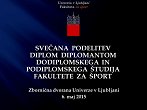



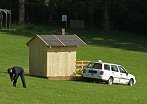




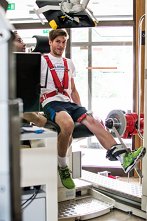





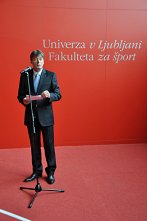
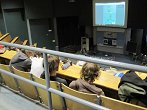




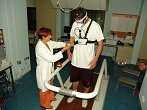

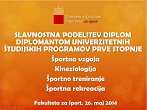


.png)